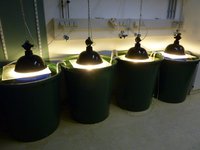Long-term dynamics of plankton communities in mesocosms

Scientists involved in the USELab project have an excellent expertise in the research field of brackish water plankton dynamics. Especially the discovery of chaos in a long-term mesocosm experiment received high appreciation (Beninca et al. 2008, 2009). Based on pilot mesocosm experiments during the first phase of USELab, the complex dynamics of plankton communities will be further investigated during the consolidation period. A new long-term experiment was launched at the beginning of the project and has been running for already 11 months. Four parallel mesocosms with brackish water conditions have been established and sampled regularly for four trophic levels: bacteria, picoplankton, phytoplankton, and zooplankton, as well as for chemical parameters.
Biodiversity of plankton communities
Within the USELab project, ecologists from Russia and Germany study the biodiversity patterns of aquatic organisms of different size classes and ecological groups in brackish waters of the Baltic Sea. Whereas macroalgae diversity supports the Artenminimum concept of Remane (Schubert et al. 2011), an unexpectedly high species richness of phyto- and zooplankton with dominance by protists was discovered in the horohalinicum of the Baltic Sea, and a new “protistan species-maximum concept” was proposed (Telesh et al. 2011). Long-term data show that eukaryotic and prokaryotic microbes in plankton demonstrate maximum species richness in the challenging zone of critical salinity 5–8, where the large-bodied bottom dwellers (macrozoobenthos, macroalgae and aquatic higher plants) experience dramatic salinity stress which leads to the impoverished diversity. The USELab studies propose a theoretical framework for explanation why diversity of small, fast-developing, rapidly evolving unicellular plankton organisms benefit from relative vacancy of brackish-water ecological niches and impaired competitiveness therein (Telesh et al., 2013). These new results challenge the major brackish-water biodiversity paradigm, support new conceptual models, and stimulate research into the fine molecular and physiological mechanisms (HSP-expression, mixotrophy) that are responsible for the high adaptability of planktonic microbes to salinity fluctuations.
References
Schubert, H., Schumann, R., Feike, M., Schoor, A., Paul, C., Heerkloss, R., Telesh, I., Skarlato, S. (2017): Studying plankton community dynamics – an optimized mesocosm design. Rostocker Meeresbiologische Beiträge 27:127-146 (https://www.oekologie.uni-rostock.de/rostocker-meeresbiol-beitraege/).
Schubert, H., Telesh, I., Nikinmaa, M., Skarlato, S. (2017): Physiological adaptations. Chapter 7, In: P. Snoeijs-Leijonmalm, H. Schubert, T. Radziejewska (Eds), Biological Oceanography of the Baltic Sea. Springer Science+Business Media Dordrecht, pp. 255-278. DOI 10.1007/978-94-007-0668-2_7.
Schubert, H., Telesh, I. (2017): Estuaries and coastal lagoons. Chapter 13, In: P. Snoeijs-Leijonmalm, H. Schubert, T. Radziejewska (Eds), Biological Oceanography of the Baltic Sea. Springer Science+Business Media Dordrecht, pp. 483-509. DOI 10.1007/978-94-007-0668-2_13.
Telesh, I.V., Schubert, H., Skarlato, S.O. (2016): Ecological niche partitioning of invasive dinoflagellate Prorocentrum minimum and its native congeners in the Baltic Sea. Harmful Algae 59:100-111; doi:10.1016/j.hal.2016.09.006.
Telesh, I., Skarlato, S., Kube, S., Rohde, H., Schubert, H. (2015): Zooplankton of the Baltic Sea: Introduction to the Distant Learning Module. Universität Rostock. Rostock & St. Petersburg. 124 p. (Textbook; ISBN 978-3-860009-441-9).
Telesh, I.V., Schubert, H., Skarlato, S.O. (2015): Size, seasonality, or salinity: What drives the protistan species maximum in the horohalinicum? Estuar. Coast. Shelf Sci. 161:102–111; doi:10.1016/j.ecss.2015.05.003.
Telesh, I. Schubert, H., Skarlato, S. (2013): Life in the salinity gradient: Discovering mechanisms behind a new biodiversity pattern. Estuar. Coast. Shelf Sci. 132:317-327.
Telesh, I., Schubert, H., Skarlato, S. (2011): Revisiting Remane’s concept: evidence for high plankton diversity and a protistan species maximum in the horohalinicum of the Baltic Sea. Mar. Ecol. Prog. Ser. 421: 1-11.
Schubert, H., Feuerpfeil, P., Marquardt, R., Telesh, I., Skarlato, S. (2011): Macroalgal diversity along the Baltic Sea salinity gradient challenges Remane’s species-minimum concept. Mar. Poll. Bull. 62: 1948-1956.
Beninca, E., Jöhnk, KD., Heerkloss, R., Huisman, J. (2009): Coupled predator-prey oscillations in a chaotic food web. Ecology Letters 12: 1367-1378.
Beninca, E., Huisman, J., Heerkloss, R., Jöhnk, KD., Branco, P., Van Nes, EH., Scheffer, M., Ellner, S. (2008): Chaos in a long-term experiment with a plankton community. Nature, 451: 822-826.



